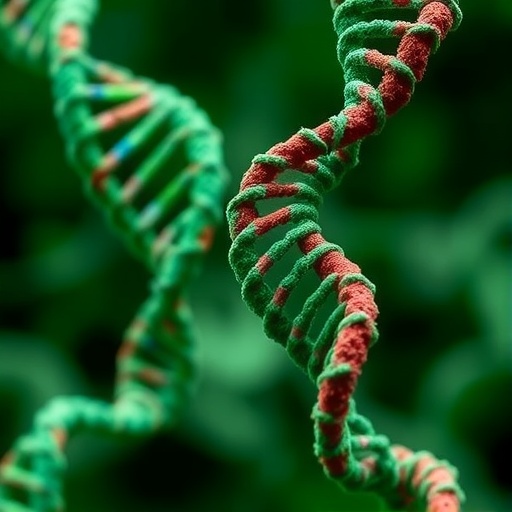A newly uncovered mechanism reveals how DNA2, an enzyme long recognized for its role in DNA replication and repair, is essential for cell proliferation by limiting aberrant replication processes and enforcing cell-cycle arrest. In a groundbreaking study published in Nature, researchers have demonstrated that DNA2 prevents the accumulation of stalled replication intermediates through its coordinated nuclease and helicase activities, thereby safeguarding genome integrity and preventing unchecked cell division.
The team focused on the consequences of DNA2 depletion in human RPE-1 cells by using an inducible degron system combined with DIA treatment to induce rapid DNA2 degradation. This model allowed the researchers to monitor cellular responses to acute DNA2 loss without introducing exogenous DNA damage. Intriguingly, they found that cells deficient in DNA2 activate ATR-dependent checkpoint signaling, which culminates in phosphorylation of CHK1, a key effector in the DNA damage response pathway, even in the absence of external genotoxic stress.
This CHK1 phosphorylation peaks around 12 hours after DNA2 is depleted, preceding the gradual degradation of the CHK1 protein itself—a hallmark of cells exiting from the G2 phase of the cell cycle. Concomitantly, levels of the cyclin-dependent kinase inhibitor p21 rise significantly and persist, suggesting an irreversible commitment to cell-cycle withdrawal. The accumulation of p21 plays a pivotal role by sequestering cyclin B1 within the nucleus and promoting its degradation, effectively preventing mitotic entry and pushing cells toward senescence.
Further observations revealed a compelling relocalization of cyclin B1 from the cytoplasm to the nucleus in DNA2-depleted cells, preceding nuclear enlargement, a quintessential marker of cellular senescence. By tracking β-galactosidase activity, a classical senescence biomarker, the researchers confirmed that these cells adopt a senescent phenotype over a 14-day period following DNA2 loss. This phenotype mirrors the effects of pharmacological induction of senescence, reinforcing the link between DNA2 function and cell fate decisions post-replication stress.
Notably, ATR inhibition or siRNA-mediated knockdown of p21 alleviated this senescent arrest, allowing cells to bypass the mitotic block instituted by DNA2 deficiency. However, this escape was achieved at a cost: the appearance of micronuclei, indicative of genomic instability stemming from incomplete or defective chromosomal replication. This finding highlights the critical checkpoint function DNA2 exerts in ensuring that replication intermediates are adequately resolved before cell division occurs.
Examining replication protein A (RPA) foci, the researchers observed that DNA2 loss triggers RAD51-dependent accumulation of RPA bound to single-stranded DNA (ssDNA) in G2 phase cells. This accumulation coincided with the nuclear translocation and eventual disappearance of cyclin B1, underscoring a mechanistic link between stalled replication intermediates and checkpoint-enforced cell-cycle exit. Surprisingly, DNA double-strand break-specific phosphorylation of RPA32 was infrequent, suggesting that the replication stress induced by DNA2 depletion involves stalled, unbroken replication forks rather than extensive DNA breakage.
Mechanistically, DNA2 appears to act at stalled replication forks by processing DNA intermediates, counteracting fork reversal and promoting fork reactivation. The loss of DNA2 leads to persistent reversed forks, which give rise to a phenomenon termed homologous recombination restarted replication (HoRReR). HoRReR involves unscheduled recombination-dependent DNA synthesis that generates ssDNA, thereby triggering ATR checkpoint activation and enforcing G2 arrest.
Complementation experiments utilizing mutant DNA2 variants revealed that both the nuclease and helicase activities are indispensable for suppressing the deleterious phenotypes observed upon DNA2 loss. Only the expression of wild-type DNA2 could restore replication fork stability and prevent aberrant checkpoint activation, demonstrating the coordinated enzymatic functions necessary for maintaining replication fidelity.
These insights significantly refine our understanding of DNA2’s essentiality for cell proliferation by connecting its enzymatic role at replication forks to a broader cellular response that safeguards genome stability. The inability to properly process reversed replication forks initiates a cascade of events: excessive recombination-based DNA synthesis, ssDNA accumulation, ATR-dependent checkpoint signaling, p21-mediated cyclin B1 sequestration, and ultimately, permanent cell-cycle exit.
This work expands the paradigm of replication stress responses by identifying DNA2 as a crucial gatekeeper that restricts aberrant recombination-restarted replication and enforces cell-cycle withdrawal before mitosis. It underscores the fine balance cells must strike between repair and proliferation and highlights DNA2 as a potential therapeutic target in diseases characterized by dysregulated replication stress responses, such as cancer.
Moreover, the findings suggest that therapeutic modulation of DNA2 activity might sensitize cells to replication stress or promote senescence in rapidly dividing tumor cells. Conversely, inhibition of downstream effectors such as p21 may allow cells to override replication stress-induced checkpoints, albeit at the risk of increased genomic instability—a double-edged sword in cancer therapy.
Future investigations will likely explore how DNA2 interfaces with other replisome components and DNA repair factors to orchestrate replication fork dynamics. Understanding the interplay between DNA2 and the ATR–CHK1–p21 axis may unveil novel strategies for manipulating checkpoint responses and controlling cell proliferation under replicative stress conditions.
Ultimately, this study shines a spotlight on the intricate molecular choreography required to preserve genome integrity during DNA replication. DNA2’s role transcends mere enzymatic activity; it enforces a cellular checkpoint that prevents catastrophic chromosomal missegregation, thereby ensuring faithful cell division and organismal homeostasis.
Subject of Research:
Role of DNA2 in replication fork processing, ATR checkpoint activation, and cell-cycle exit mechanisms in human cells.
Article Title:
DNA2 enables growth by restricting recombination-restarted replication.
Article References:
Hudson, J.J.R., Appanah, R., Jones, D. et al. DNA2 enables growth by restricting recombination-restarted replication. Nature (2025). https://doi.org/10.1038/s41586-025-09470-5
Image Credits: AI Generated




